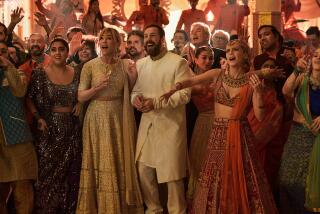Films starring women earn more money than male-led movies, says new study
âThereâs just no telling how far Iâll go,â sings the titular princess in the hit Disney movie âMoana.â The same can be said of female-led films altogether, as new data proves that movies starring women make more money than those starring men.
According to research released Tuesday, there is a strong correlation between female-led films and box office success. The study â conducted by Creative Artists Agency and the tech-focused firm shift7, and created in conjunction with Timeâs Up â examined 350 top-grossing U.S. films released from 2014 through 2017.
It categorized them into production budget levels (using reported data by Gracenote) and identified which listed a woman as its lead actor (in its press notes or final credits, for example). It turned out that, regardless of budget level, films with female leads outperformed male-led ones in worldwide box office averages.
Additionally, the new research revealed that films that passed the Bechdel Test â a gender-representation measurement in which two female characters discuss a topic other than a man â earned more money than those that failed it. In fact, no movie has grossed more than $1 billion worldwide without passing the Bechdel Test since 2012.
Despite their consistent box-office success, female-led films are often seen as an anomaly in Hollywood.
The Times spoke with CAA agent Christy Haubegger and shift7 CEO and founder Megan Smith, who were both involved with the study, about what these findings could mean for the future of the film industry.
Why do this research?
Smith: Our group within Timeâs Up is focused on authentic storytelling and diverse representation on screen. We wanted to look at economic data and the myths that live around the industry. Christy and CAA had done some amazing work on race and inclusion, and this builds on that.
Haubegger: Thereâs a lot of things that become conventional wisdom in any business, and after a while that âknowledgeâ is passed down just through company cultures and from executives training other executives. Why donât we see more female protagonists? Some members of the group, who are producers and executives, said, âPeople donât make those stories because they donât make as much money.â I donât know if anyone ever stopped to question that assumption. We decided to just look and see if itâs true, at least in certain cases. Weâre making a really modest point here! The idea that women as lead characters make less money is not backed up by the data. Thatâs it.
What surprised you while conducting the research?
Haubegger: Who was first on the call sheet and listed as the lead. There are a number of pictures where you could call someone a co-lead, and itâs very much a two-hander. For example, a lot of us think of âMad Max: Fury Roadâ as Charlize Theronâs movie, but Tom Hardy is first because heâs the titular character, so we categorized it as a male-led movie [for our research]. It made me more certain of the data. It underscored the point that even without the benefit of high-performing outliers like that, still within that budget bucket, it still holds true that [female-led movies make more money.]
Smith: They just underscore the need to really look at what audiences want and transform the industry. It speaks to the balance we all hope for. Itâs the right thing to do, financially and for humanity as well.
Haubegger: What also surprised me is how clustered female-led movies are in the $30-$50 million range â thatâs a rom-com, or another smaller commercial movie, and people just arenât making them anymore. I wonder if part of the reason that theyâre clustered there is from the perception. If we think thatâs the purview of women and weâre making few of those movies, and we think of $100-million movies as for men, and weâre making more, then we wonât see much of a shift.
This year, four movies have grossed more than $1 billion worldwide: âBlack Panther,â âAvengers: Infinity War,â âIncredibles 2,â âJurassic World: Fallen Kingdom.â All of them pass the Bechdel Test, aligning with the study. Why do you think that is?
Haubegger: To get to a billion dollars, you have to be a good movie, and a good movie has dimensionalized characters. You canât hit a billion if men only want to see this film! You have to appeal to men and women.
Smith: The Bechdel Test is such a low bar, really. The vast majority of people are not familiar with it, but itâs astonishing how often you could be watching a movie for two hours and not see a single conversation that fits. Itâs more than the movie â when female talent is featured on the one sheet and the trailer, itâs an asset.
We thought this was important to look at because even if you have a female lead, is there enough other women to talk to? Look at the early âStar Warsâ movies: Carrie Fisher only talks to men. If thereâs not enough women to talk to, the imbalance stays.
Haubegger: And in my opinion, what people call âdiversityâ and âinclusionâ is really just innovation. âCrazy Rich Asiansâ was a hit because we havenât seen an Asian American love story. Looking at the data, 30% of the opening weekend audience was Asian , which means that audience over-indexed six times! But the majority of the people who went to see the movie were not Asian American! The thing that surprises people is that films with female characters appeal certainly to women, but to everybody. People are simply seeking innovations of stories they havenât seen yet.
What industry effect do you hope this study has?
Smith: I hope it empowers everyone across the board to have more confidence about [making female-led films]. This is proof of how powerful it is for the bottom line.
Haubegger: I should be more ambitious, but I really hope it takes that old myth away. A lot of things donât move forward early in development because they think the audience isnât there. But women make up half of the moviegoing audience and only a third of the protagonists, so we probably have an underserved and hungry audience who notices when we see ourselves portrayed. Itâs very easy to say, âItâs just movies and television.â But it changes what we see in ourselves and what we see in other people. You canât be what you canât imagine. So letâs look at films on their merit and quality, and use real comps, not assumptions. I mean, itâs show business, not show art!
Twitter: @cashleelee
More to Read
The biggest entertainment stories
Get our big stories about Hollywood, film, television, music, arts, culture and more right in your inbox as soon as they publish.
You may occasionally receive promotional content from the Los Angeles Times.











